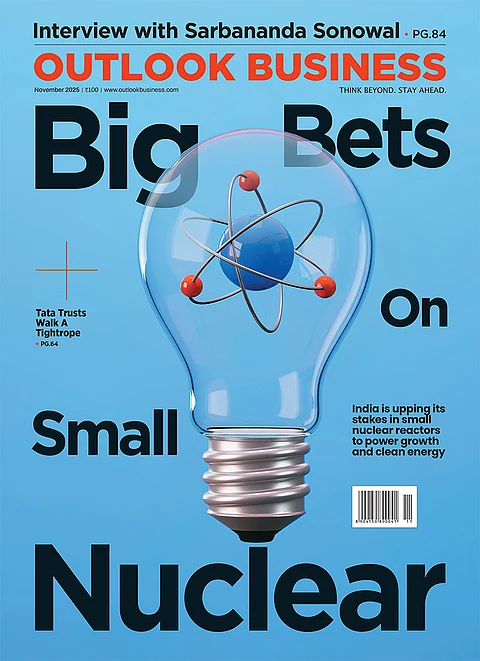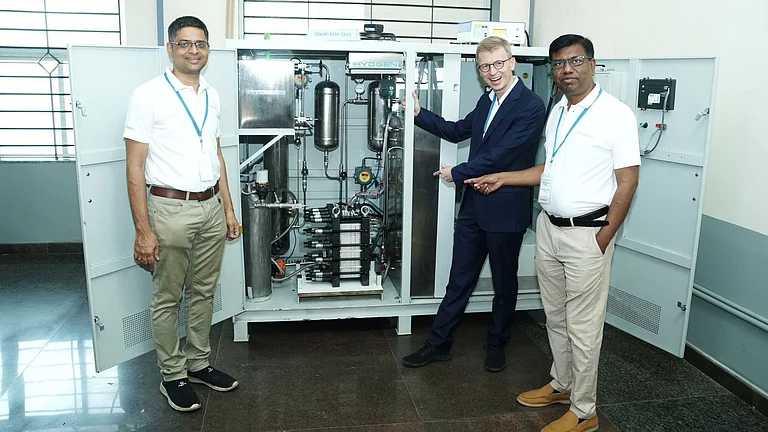India’s space-tech sector has evolved in the last few years to accommodate a lot of private sector participation. This has been a major departure from the historical practice of restricting the space sector predominantly to governmental entities such as the Indian Space Research Organization, or ISRO. The fact that more than 150 private start-ups have risen and joined the space party in the past decade is a testimony to this. One of the early entrants, Skyroot Aerospace, even pioneered the launch of India’s first privately built rocket in November 2022. Lately, the Union government has rolled out steps to advance India’s space program by building on the increasing capabilities of mushrooming space-tech startups.
In an exclusive conversation with AgniKul Cosmos, Srinath Ravichandran, the co-founder and chief executive of the IIT Madras-backed launch vehicle building startup, tells Outlook Business the state of Indian space-tech startups amid recent policy developments, the key challenges the sector faces, the increasing role of 3D printing in space-tech manufacturing, and what the future holds for the sector.
Edited Excerpts:
Earlier this year, the government liberalized limits on foreign funds coming into the sector. Do you see a lot of FDI coming in with this, or is it largely domestic capital that is moving around currently?
I think FDI has come in bits and pieces. At least in the sectors where there is clarity. I think we are at a place where all the startups that are out there have already gotten the easily available money in the country. But for the next rounds of funding, where everyone is going to be looking at larger checks, I think FDI will make a difference.
If you are raising $5 to $10 million, that money is somewhat available across the country. But if you are looking to raise bigger sums, say $100 million, the whole story changes. I think we'll have to see how the story plays out.
There have been quite a few policy-level developments in India’s space-tech sector, including the notification of the Indian Space Policy, 2023, last year. How conducive has overall policymaking been for private space-tech companies?
I think both from an industry standpoint, say launch or satellites or ground software, or from an immediate action standpoint, be it a large company or a startup, I think things are actually happening. So, it has reflected quite well into reality.
When a company like Skyroot launches, it's very clear that it’s a victory for paperwork. It shows that you can launch from India privately. Similarly, Dhruva and Pixxel have launched with ISRO, and we are also preparing to launch. It clearly shows that the government is very serious about implementing it.
At an overall policy level, there are a couple of clear advantages. One is that they have tried to make it as single as possible, which is good. No running around. Next, I think it is quite futuristic because it addresses not only basic things like launch and satellite operations but also talks about setting up launch pads, attempting reusability, and suborbital. Many things that are in the development phase across the world have also been addressed in the policy.
Could you tell us how the role of 3D printing has evolved in the space-tech landscape?
Metal 3D printing works well when you have a few components to print and must make extremely complex geometries. It is nicely cut out for launch vehicles and certain satellite components because you're not going to make a million rockets.
For engines, certain aspects of the tank, or systems like mounts and structures within the vehicle, I think 3D printing will really do the job. I think people love it in aerospace, mainly for that reason.
How could this impact the cost and time spent on developing a product?
3D printing allows you to iterate hardware at the speed of iterating software, which is, I think, an extremely complex thing with conventional manufacturing, where each time you need to do something, you must start with the mold, mount, and fixture. In 3D printing, nothing is required. Put the right CAD model in it, allow it to be designed by 3D printing, and you have something that you can directly iterate on.
What are the key challenges within the sector that need to be addressed in the upcoming months?
I'll go back to the scaling aspect. That is one thing to figure out for all of us. I think the challenge is not just scaling, but scaling with quality. Usually, what happens is that scaling and quality don't come together. When you start scaling and doing multiple things, the quality tends to take a beating. But there can be no such thing as a low-quality space product. So, scaling along with quality is the real challenge.
For instance, we are all aware of SpaceX doing 100 launches a year. What is the challenge of doing things like SpaceX? Probably, it is to crack how to do 100 launches a year at the level of quality it takes to build an orbital-class product. That, I think, is going to be something that needs to be figured out.
How is the funding scenario for the sector currently?
Overall, space technology has become more accepted. It was almost like an offbeat idea in 2017 when we started. Today, it's an interesting sector to bet on for VCs and investors. With the early-stage funding, I think the message is that this is a clear sector to bet on and get returns on. You can build business models out of it.
We are all in pursuit of the next round of money. But for that, two or three things may have to happen. Firstly, you must show technological maturity, get a few launches done, get a few satellites out there, and make some revenue. At the same time, the policy is also opening for FDI, so I think it's a matter of time before a late-stage community starts realizing that space-tech business models at scale can be built out of India.
You have delayed the launch of your Agnibaan rocket a couple of times. What were the lessons learned?
I think every time you do something for the first time, there is something new to figure out. For us, since we've already made two attempts, we understand the lead-up to the launch. We have learned lessons in terms of better time management, better communication across various stakeholders within ISRO, and better team management in terms of adhering to timelines.
Where does AgniKul go from here on?
Basically, there is a business model. On Excel files, you can show it. The question is how you show that in hardware and in reality by actually building products. We are able to get to the point of saying, now that one launch will be done soon, how to plan the next set of launches, who the next set of customers will be, and how to start incorporating more tests into our future launches. Like I said, it is going to be about scaling for us.





























